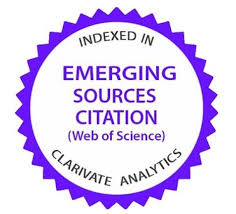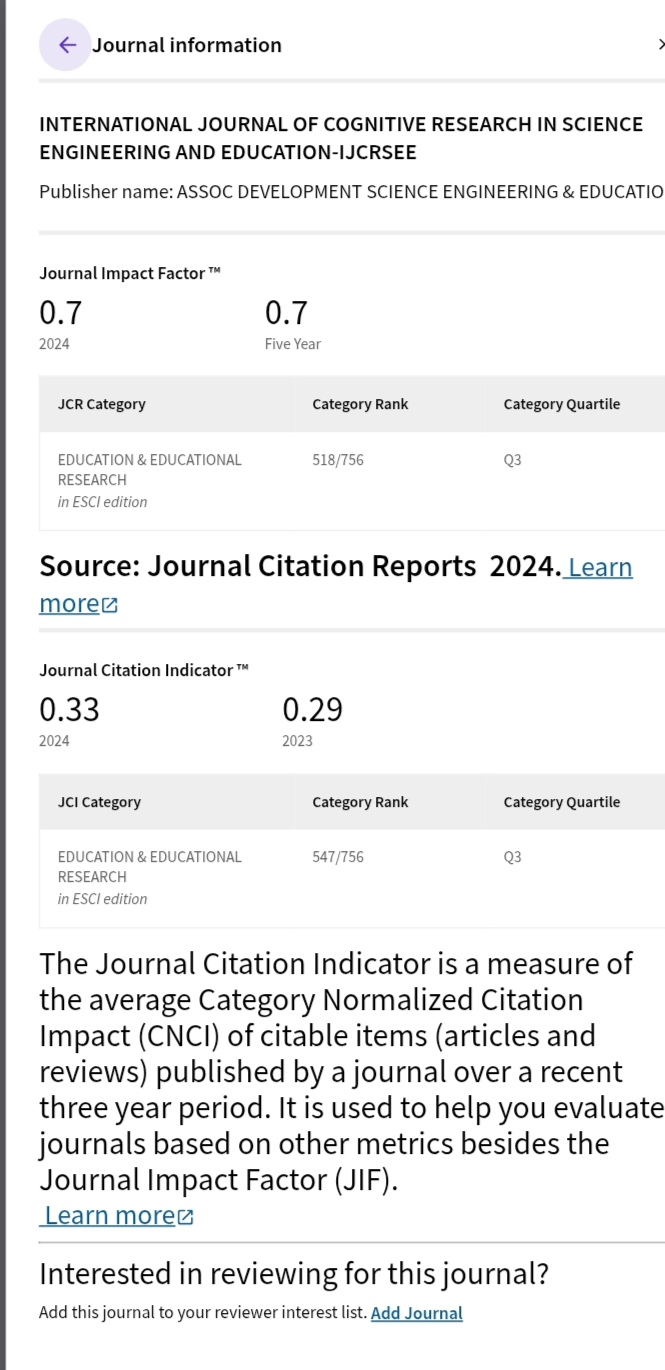Attitudes of Teachers to Using Information and Communication Technology in Teaching – Advantages and Obstacles
DOI:
https://doi.org/10.23947/2334-8496-2022-10-2-69-76Keywords:
ICT in teaching; advantages of ICT in teaching, obstacles of ICT in teaching, innovation, modern teachingAbstract
This paper analyses the attitudes of teachers to using information and communication technology in teaching. The study was conducted on a sample of 269 teachers in the Republic of Serbia. The purpose of this research is to look at the intensity of ICT use in teaching, as well as to identify the benefits and obstacles that teachers face when using this technology. The study was based on a descriptive research methodology. Surveying and scaling techniques were used to measure the attitudes of teachers. It was concluded that teachers often use ICT in teaching. The greatest advantage of ICT use, as seen by teachers, is improved quality of teaching, a possibility to deliver interesting lessons and quick and easy access to information. The greatest obstacles emphasized by teachers were underdeveloped competencies of teachers, limited access to ICT in schools and insufficient trust in the use of new technologies.
Downloads
References
Agrawal, A. K., & Mittal, G. K. (2018). The Role of ICT in Higher Education for the 21st Century: ICT as A Change Agent for Education. Multidisciplinary Higher Education, Research, Dynamics & Concepts: Opportunities & Challenges For Sustainable Development, 1(1), 76-83.
Al-Ansi, Abdullah M., Askar Garad, & Ahmed Al-Ansi (2021). “ICT-based learning during COVID-19 outbreak: Advantages, opportunities and challenges. Gagasan Pendidikan Indonesia, 2(1), 10-26. https://doi.org/10.30870/gpi.v2i1.10176 DOI: https://doi.org/10.30870/gpi.v2i1.10176
Almekhlafi, A. G., & Almeqdadi, F. A. (2010). Teachers’ perceptions of technology integration in the United Arab Emirates school classrooms. Journal of Educational Technology & Society, 13(1), 165-175.
Andevski, M. Vidaković, M. & Arsenijevič, O. (2014). Internet u nastavi i učenju [Internet in teaching and learning.]. Zbornik radova sa međunarodne konferencije Univerziteta Singidunum, Beograd: Sinteza, p.368–374.
Arsenijević, O. (2014). Internet u nastavi i učenju [Internet in teaching and learning]. Sinteza 2014-Impact of the Internet on Business Activities in Serbia and Worldwide, 368-374. https://doi.org/10.15308/sinteza-2014-368-374 DOI: https://doi.org/10.15308/sinteza-2014-368-374
Balanskat A., & Blamire R. (2007). ICT in Schools, European Schoolnet.
Barak, M. (2014). Closing the gap between attitudes and perceptions about ICT-enhanced learning among pre-service STEM teachers. Journal of Science Education and Technology, 23(1), 1-14. https://doi.org/10.1007/s10956-013-9446-8 DOI: https://doi.org/10.1007/s10956-013-9446-8
Bhatti, M. S., Asif Iqbal, Shaista Noreen, Rafia Mukhtar, & Zahida Javed. (2021). Investigating the Role of ICT for Teaching English at Elementary Level. AsiaCALL Online Journal, 12(2), 87-93. Retrieved from https://asiacall.info/acoj/index.php/journal/article/view/35
Braš-Roth, M., Markočić-Dekanić, A., & Ružić, D. (2014). ICILS 2013, Preparing for Life in the Digital Age. Zagreb: National Center for External Evaluation of Education-PISA Center.
Džigurski, S., Simić, S., Marković, S., & Šćepanović, D. (2013). Research on the use of information and communication technologies in schools in Serbia. Social Inclusion and Poverty Reduction Unit, Office of the Deputy Prime Minister for European Integration of Serbia. Retrieved from http://socijalno ukljucivanje.gov.rs/wp-content/uploads/2014/06/Istrazivanje-o-upotrebiIKT-u-skolama-u-Srbiji -jun-2013
Empirica, (2006). Benchmarking Access and Use of ICT in European School. Retrieved from https://www.empirica.com/publikationen/documents/No08-2006_learnInd.pdf
European Commision (2013). Survey in Schools: ICT in Education Benchmarking Access, Use and Attitudes to Technology in Europe’s Schools. Luxembourg: European Union.
Hixon, E., & So, H. J. (2009). Technology’s role in field experiences for preservice teacher training. Journal of Educational Technology & Society, 12(4), 294-304. Retrieved from http://galleries.lakeheadu.ca/uploads/4/0/5/9/4059357/tech_role_in_pst.pdf
Hu, X., Gong, Y., Lai, C., & Leung, F. K. (2018). The relationship between ICT and student literacy in mathematics, reading, and science across 44 countries: A multilevel analysis. Computers & Education, 125, 1-13. https://doi.org/10.1016/j.compedu.2018.05.021 DOI: https://doi.org/10.1016/j.compedu.2018.05.021
Kadijevich, D. M. (2012). TPCK framework: assessing teachers’ knowledge and designing courses for their professional development. British Journal of Educational Technology, 43(1), E28-E30. https://doi.org/10.1111/j.1467-8535.2011.01246.x DOI: https://doi.org/10.1111/j.1467-8535.2011.01246.x
Korte, W. B., & Hüsing, T. (2006). Benchmarking access and use of ICT in European schools 2006. Empirica, Ges. für Kommunikations-und Technologieforschung. Results from Head Teacher and A Classroom Teacher Surveys in 27 European Countries. Retrieved from http://www.empirica.biz/publikationen/documents/Learnind_paper_Korte_Huesing_Code_427_$nal.pdf
Lane, C. A., & Lyle, H. F. (2011). Obstacles and supports related to the use of educational technologies: The role of technological expertise, gender, and age. Journal of Computing in Higher Education, 23(1), 38-59. https://doi.org/10.1007/s12528-010-9034-3 DOI: https://doi.org/10.1007/s12528-010-9034-3
Legrain, P., Gillet, N., Gernigon, C., & Lafreniere, M. A. (2015). Integration of information and communication technology and pupils’ motivation in a physical education setting. Journal of teaching in Physical Education, 34(3), 384-401. https://doi.org/10.1123/jtpe.2014-0013 DOI: https://doi.org/10.1123/jtpe.2014-0013
Lindberg, J. O., Olofsson, A. D., & Fransson, G. (2016). Contrasting views: Student and teacher perceptions on ICT in education. In ICICTE 2016, International Conference on Information and Communication Technologies in Education, Rhodes, Greece, 7-9 July, 2016 (pp. 1-10). Retrieved from https://www.diva-portal.org/smash/get/diva2:967758/FULLTEXT01.pdf
Machin, S. J., McNally, S., & Silva, O. (2006). New Technology in Schools: Is There a Payoff? IZA Discussion Paper No. 2234, Available at SSRN: http://dx.doi.org/10.2139/ssrn.923543 DOI: https://doi.org/10.2139/ssrn.923543
Mandić, D. (2009). Informative concept of teaching in the school of the future. In the Proceedings of the Future School. Belgrade: Serbian Academy of Education, p.802-815.
Milutinović V. (2016). Examination of the acceptance of innovative use of computers in teaching mathematics for future teachers and mathematics teachers, Insitute for Educational Research, 48(2), 339–366. DOI: https://doi.org/10.2298/ZIPI1602339M
Molnár, G. (2014). Modern ICT based teaching and learning support systems and solutions in higher education practice. In 10th International Scientific Conference on Distance Learning in Applied Informatics (pp. 421-430). Retrieved from http://real.mtak.hu/117231/1/Divai2014_proc_MGY.pdf
Nurliani, R., Sinaga, P., & Rusdiana, D. (2021, March). Problems of online learning and the use of information and communication technology (ICT) in physics learning at Sumedang, West Java. In Journal of Physics: Conference Series (Vol. 1806, No. 1, p. 012043). IOP Publishing. https://doi.org/10.1088/1742-6596/1806/1/012043 DOI: https://doi.org/10.1088/1742-6596/1806/1/012043
Ramboll Management (2004). ‘Study on Innovative Learning Environments in School Education, Final Report’, Denmark: Ramboll Management.
Ramboll Management (2006). ‘Elearning Nordic 2006: Impact of ICT on Education’, Denmark: Ramboll Management.
Scherer, R., & Hatlevik, O. E. (2017). “Sore eyes and distracted” or “excited and confident”?–The role of perceived negative consequences of using ICT for perceived usefulness and self-efficacy. Computers & Education, 115, 188-200. https://doi.org/10.1016/j.compedu.2017.08.003 DOI: https://doi.org/10.1016/j.compedu.2017.08.003
Sipilä, K. (2014). Educational use of information and communications technology: Teachers’ perspective. Technology, Pedagogy and Education, 23(2), 225-241. https://doi.org/10.1080/1475939X.2013.813407 DOI: https://doi.org/10.1080/1475939X.2013.813407
Stamoulis, E., & Plakitsi, K. (2009). Activity Theory As A Tool For Analyzing Primary Science Learning Environments Enriched By History And Philosophy Of Science And Also ICT Technologies. In ESERA, Conference Istanbul (p. 349).
Stošić, L., & Stošić, I. (2015). Perceptions of teachers regarding the implementation of the internet in education. Computers in Human Behavior, 53, 462-468. https://doi.org/10.1016/j.chb.2015.07.027 DOI: https://doi.org/10.1016/j.chb.2015.07.027
Teo, T., Milutinović, V., & Zhou, M. (2016). Modelling Serbian pre-service teachers’ attitudes towards computer use: A SEM and MIMIC approach. Computers & Education, 94, 77-88. https://doi.org/10.1016/j.compedu.2015.10.022 DOI: https://doi.org/10.1016/j.compedu.2015.10.022
Thaheem, S. K., Abidin, M. J. Z., Mirza, Q., & Pathan, H. U. (2021). Online teaching benefits and challenges during pandemic COVID-19: a comparative study of Pakistan and Indonesia. Asian Education and Development Studies. https://doi.org/10.1108/AEDS-08-2020-0189 DOI: https://doi.org/10.1108/AEDS-08-2020-0189
The National Education Council (2013). Guidelines for the Improvement of the Role of ICT in Education. Belgrade.
Tsegay, S. M., Ashraf, M. A., Perveen, S., & Zegergish, M. Z. (2022). Online teaching during COVID-19 pandemic: Teachers’ experiences from a Chinese university. Sustainability, 14(1), 568. https://doi.org/10.3390/su14010568 DOI: https://doi.org/10.3390/su14010568
Villalba, A., González-Rivera, M. D., & Díaz-Pulido, B. (2017). Obstacles Perceived by Physical Education Teachers to Integrating ICT. Turkish Online Journal of Educational Technology-TOJET, 16(1), 83-92. Retrieved from https://files.eric.ed.gov/fulltext/EJ1124906.pdf
Vrasidas, C. (2015). The rhetoric of reform and teachers’ use of ICT. British Journal of Educational Technology, 46(2), 370-380. https://doi.org/10.1111/bjet.12149 DOI: https://doi.org/10.1111/bjet.12149
Wachira, P., & Keengwe, J. (2011). Technology integration barriers: Urban school mathematics teachers perspectives. Journal of science education and technology, 20(1), 17-25. https://doi.org/10.1007/s10956-010-9230-y DOI: https://doi.org/10.1007/s10956-010-9230-y
Ward, L., & Parr, J. M. (2010). Revisiting and reframing use: Implications for the integration of ICT. Computers & Education, 54(1), 113-122. https://doi.org/10.1016/j.compedu.2009.07.011 DOI: https://doi.org/10.1016/j.compedu.2009.07.011
Wastiau, P., Blamire, R., Kearney, C., Quittre, V., Van de Gaer, E., & Monseur, C. (2013). The Use of ICT in Education: a survey of schools in E urope. European journal of education, 48(1), 11-27. https://doi.org/10.1111/ejed.12020 DOI: https://doi.org/10.1111/ejed.12020
Published
How to Cite
Issue
Section
Categories
License
Copyright (c) 2022 Biljana Novković Cvetković, Zvezdan Arsić, Dragan Cenić

This work is licensed under a Creative Commons Attribution 4.0 International License.
Plaudit
Accepted 2022-08-23
Published 2022-08-31











